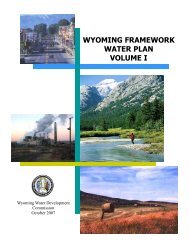Evolution of the Hoover Dam Inflow Design Flood: A Study in ...
Evolution of the Hoover Dam Inflow Design Flood: A Study in ...
Evolution of the Hoover Dam Inflow Design Flood: A Study in ...
Create successful ePaper yourself
Turn your PDF publications into a flip-book with our unique Google optimized e-Paper software.
flow above which <strong>the</strong> <strong>in</strong>cremental <strong>in</strong>crease <strong>in</strong> water surface elevation downstream<br />
due to failure <strong>of</strong> a dam or o<strong>the</strong>r water reta<strong>in</strong><strong>in</strong>g structure is no longer considered<br />
to present an unacceptable additional downstream threat.@ In this case, <strong>the</strong><br />
probable maximum flood (PMF) was selected as <strong>the</strong> <strong>in</strong>flow design flood because<br />
if <strong>the</strong> dam failed, it would result <strong>in</strong> catastrophic consequences, <strong>in</strong>clud<strong>in</strong>g loss<br />
<strong>of</strong> life. The PMF is def<strong>in</strong>ed as A<strong>the</strong> maximum run<strong>of</strong>f condition result<strong>in</strong>g from<br />
<strong>the</strong> most severe comb<strong>in</strong>ation <strong>of</strong> hydrologic and meteorologic conditions that are<br />
considered reasonably possible for <strong>the</strong> dra<strong>in</strong>age bas<strong>in</strong> under study.@ 18<br />
Reclamation used <strong>the</strong> <strong>Flood</strong> Hydrograph and Rout<strong>in</strong>g (FHAR) computer<br />
program to convert excess precipitation to run<strong>of</strong>f and generate <strong>the</strong> flood<br />
hydrograph for <strong>the</strong> ULDRS. FHAR, which was developed by Reclamation, uses<br />
unit hydrograph <strong>the</strong>ory. The program derives <strong>the</strong> flood hydrograph by apply<strong>in</strong>g<br />
<strong>in</strong>crements <strong>of</strong> excess precipitation to <strong>the</strong> unit hydrograph. The unit hydrograph is<br />
computed from <strong>the</strong> dimensionless graph, given <strong>the</strong> bas<strong>in</strong> area, lag time, and unit<br />
time.<br />
The lower and upper bas<strong>in</strong>s were divided <strong>in</strong>to 99 subbas<strong>in</strong>s for <strong>the</strong><br />
analysis. In general, subbas<strong>in</strong> del<strong>in</strong>eation was made by follow<strong>in</strong>g major tributary<br />
boundaries. Subbas<strong>in</strong>s that had similar characteristics <strong>of</strong> elevation, slope,<br />
land use, and dra<strong>in</strong>age pattern were comb<strong>in</strong>ed where possible. The size <strong>of</strong> <strong>the</strong><br />
subbas<strong>in</strong>s was limited to areas <strong>of</strong> less than 5,000 mi 2 .<br />
Field trips were made to become familiar with <strong>the</strong> subbas<strong>in</strong>s. Soil and<br />
geologic conditions, land use, vegetation type and cover, and bas<strong>in</strong> roughness and<br />
steepness were exam<strong>in</strong>ed to better estimate loss rates and lag coefficients. These<br />
observations were used for all subbas<strong>in</strong>s visited.<br />
Loss rates are a measure <strong>of</strong> <strong>the</strong> precipitation lost to <strong>in</strong>filtration,<br />
evaporation, transpiration, absorption, and m<strong>in</strong>or depression storage <strong>in</strong> <strong>the</strong><br />
bas<strong>in</strong>. In general, <strong>the</strong> lower bas<strong>in</strong> near Lake Mead and <strong>the</strong> north-side tributaries<br />
to <strong>the</strong> lake are areas <strong>of</strong> low <strong>in</strong>filtration and are subject to flash flood<strong>in</strong>g. The<br />
o<strong>the</strong>r areas and tributaries, especially Kanab Creek, Kaibab Creek, and most<br />
<strong>of</strong> <strong>the</strong> Little Colorado River bas<strong>in</strong> had somewhat higher loss rates. In <strong>the</strong>se<br />
areas, <strong>the</strong> vegetative cover was heavier, and <strong>the</strong> loss rates appeared to <strong>in</strong>crease<br />
with elevation rise. Most <strong>of</strong> <strong>the</strong> Little Colorado River bas<strong>in</strong> showed very little<br />
evidence <strong>of</strong> flash flood<strong>in</strong>g or stream channel development.<br />
In <strong>the</strong> upper bas<strong>in</strong>, those areas tributary to Lake Powell were very desertlike<br />
and exhibited signs <strong>of</strong> flash flood<strong>in</strong>g. The loss rates appeared quite low,<br />
and <strong>the</strong> vegetative cover was very sparse. Some portions <strong>of</strong> <strong>the</strong> lower Green<br />
River subbas<strong>in</strong> had extensive outcrops <strong>of</strong> Mancos Shale. The upper bas<strong>in</strong> areas<br />
exhibited a similar <strong>in</strong>crease <strong>in</strong> vegetation and loss rates with elevation rise.<br />
In applications <strong>of</strong> <strong>the</strong> unit hydrograph approach, <strong>the</strong> Reclamation lag<br />
equation is used <strong>in</strong> determ<strong>in</strong><strong>in</strong>g <strong>the</strong> lag time <strong>of</strong> <strong>the</strong> flood hydrograph. Lag time<br />
202
















